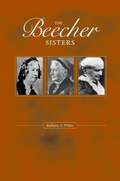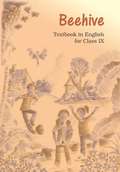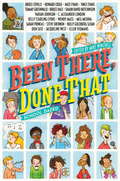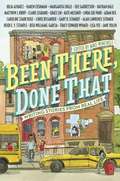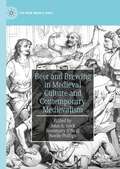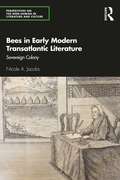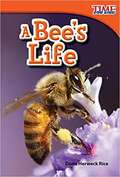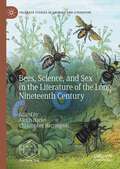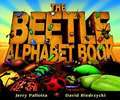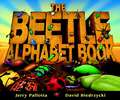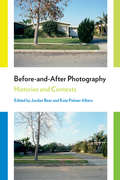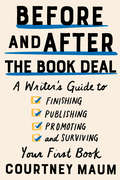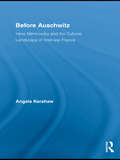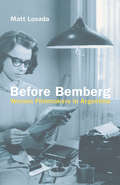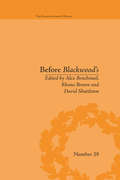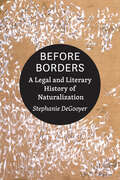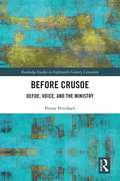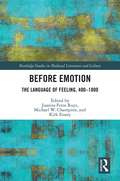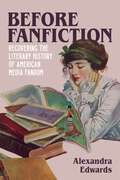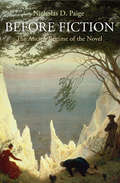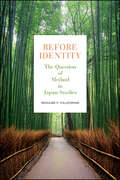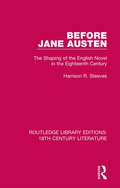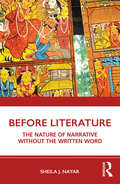- Table View
- List View
The Beecher Sisters
by Barbara Anne WhiteThe Beecher sisters--Catharine, Harriet, and Isabell A&M were three of the most prominent women in nineteenth-century America. Daughters of the famous evangelist Lyman Beecher, they could not follow their father and seven brothers into the ministry. Nonetheless, they carved out pathbreaking careers for themselves. Catharine Beecher founded the Hartford Female Seminary and devoted her life to improving women's education. Harriet Beecher Stowe became world famous as the author of Uncle Tom's Cabin. Isabella Beecher Hooker was an outspoken advocate for women's rights. This engrossing book is a joint biography of the sisters, whose lives spanned the full course of the nineteenth century. The life of Isabella Beecher--who has never been the subject of a biography--is examined in particular detail here. Drawing on little used sources, Barbara White explores Isabella's political development and her interactions with her sisters and with prominent people of the time--from Susan B. Anthony and Elizabeth Cady Stanton,to Mark Twain.
Beehive class 9 - JCERT
by Jharkhand Council of Educational Research and Training RanchiThe book Beehive for Class IX is an English textbook that aims to provide students with a rich learning experience by offering a wide variety of reading materials. It covers a range of literary genres, including short stories, biographies, autobiographies, science fiction, poems, and plays. The themes in the book address topics such as childhood, adolescence, talent, achievement, music, and environmental concerns. Through interactive exercises, students are encouraged to develop language proficiency, critical thinking, and creative skills. The book emphasizes the learner-centered approach, where students explore language through meaningful context while building comprehension and communication abilities.
Beehive class 9 - NCERT - 23
by National Council of Educational Research and Training"Beehive" is a textbook prescribed for Class 9 students by NCERT, offering a diverse collection of prose and poetry. It encompasses a range of themes and subjects, including social issues, human relationships, and personal growth. The prose section features stories that delve into the complexities of life, such as the challenges of adolescence, the importance of empathy, and the pursuit of dreams. Meanwhile, the poetry section explores emotions, nature, and the beauty of language. Through its engaging narratives and evocative verses, "Beehive" not only aims to enhance students' language skills but also encourages critical thinking and empathy by exposing them to various perspectives and experiences.
Been There, Done That: School Dazed
by Eglantine Ceulemans Mike WinchellSchool is in session as celebrated authors share their real-life academic experiences and turn them into fiction!To some kids, school means homework, bus rides, or band practice. To others it means bullies, tough teachers, or pranking the substitute. In this second collection in the Been There, Done That series, authors describe a standout story from their school days. As with the first anthology, each author will contribute a narrative nonfiction account that serves as the inspiration for an original fictional short story. The contributing award-winning and best-selling middle-grade authors include Holly Goldberg Sloan, Kelly Starling Lyons, Tommy Greenwald, Wendy Mass, Bruce Hale, Jacqueline West, Ellen Yeomans, Vince Evans, Nate Evans, Sarah Prineas, Steve Sheinkin, Shaun David Hutchinson, Don Tate, Varian Johnson, Howard Cruse, Meg Medina, C. Alexander London, and Bruce Coville.From the Hardcover edition.
Been There, Done That: Writing Stories from Real Life
by Mike Winchell Eglantine CeulemansWhere do authors get their ideas? And how do they turn those ideas into stories? This anthology looks at the process of taking real-life experiences and turning them into works of engaging fiction. The collection features award-winning and bestselling middle-grade authors who provide both original fictional short stories as well as the nonfiction accounts that inspired them. The contributing authors include Julia Alvarez, Karen Cushman, Margarita Engle, Dee Garretson, Nathan Hale, Matthew Kirby, Claire Legrand, Grace Lin, Kate Messner, Linda Sue Park, Adam Rex, Gary Schmidt, Alan Sitomer, Caroline Starr Rose, Heidi Stemple, Rita Williams-Garcia, Tracy Edward Wymer, Lisa Yee, and Jane Yolen.
Beer and Brewing in Medieval Culture and Contemporary Medievalism (The New Middle Ages)
by John A. Geck Rosemary O’Neill Noelle PhillipsBeer and Brewing in Medieval Culture and Contemporary Medievalism is a cross-cultural analysis of the role that alcohol consumption played in literature, social and cultural history, and gender roles in the Middle Ages. The volume also seeks to correct or offer new insights into historical beer production. By drawing on the expertise of scholars of history, archaeology, Old and Middle English, Old Norse, and Medieval and Early Modern literature, the book shows how historical medieval beer and brewing has influenced nostalgic post-medieval nationalism and romanticized visions of the medieval ale-house seen in beer marketing today. The essays describe alcohol consumption in the Middle Ages across much of Northern Europe, engage with the various myths employed in modern craft beer advertising and beer production, and examine how gender intersects with beer production and consumption. The editors also raise certain critical questions about medievalisms which need to be interrogated, particularly in light of the continued use of the Middle Ages for white supremacist and colonialist ideals. The volume contributes to the study of the popular and historical understandings of the Middle Ages as well the issues of race and gender.
Bees in Early Modern Transatlantic Literature: Sovereign Colony (Perspectives on the Non-Human in Literature and Culture)
by Nicole A. JacobsThis book examines apian imagery—bees, drones, honey, and the hive—in the seventeenth- and eighteenth-century literary and oral traditions. In England and the New World colonies during a critical period of expansion, the metaphor of this communal society faced unprecedented challenges even as it came to emblematize the process of colonization itself. The beehive connected the labor of those marginalized by race, class, gender, or species to larger considerations of sovereignty. This study examines the works of William Shakespeare; Francis Daniel Pastorius; Hopi, Wyandotte, and Pocasset cultures; John Milton; Hester Pulter; and Bernard Mandeville. Its contribution lies in its exploration of the simultaneously recuperative and destructive narratives that place the bee at the nexus of the human, the animal, and the environment. The book argues that bees play a central representational and physical role in shaping conflicts over hierarchies of the early transatlantic world.
A Bees' Life (Time For Kids®: Informational Text)
by Dona Herweck RiceHow does a small egg become a buzzing bee? With a graph of a bee's life cycle, vivid photos, explanatory vocabulary, and informational text, readers are sure to be captivated! About Shell Education Rachelle Cracchiolo started the company with a friend and fellow teacher. Both were eager to share their ideas and passion for education with other classroom leaders. What began as a hobby, selling lesson plans to local stores, became a part-time job after a full day of teaching, and eventually blossomed into Teacher Created Materials. The story continued in 2004 with the launch of Shell Education and the introduction of professional resources and classroom application books designed to support Teacher Created Materials curriculum resources. Today, Teacher Created Materials and Shell Education are two of the most recognized names in educational publishing around the world.
Bees, Science, and Sex in the Literature of the Long Nineteenth Century (Palgrave Studies in Animals and Literature)
by Alexis Harley Christopher HarringtonThe long nineteenth century (1789-1914) has been described as an axial age in the history of both bees and literature. It was the period in which the ecological and agronomic values that are still attributed to bees by modern industrial society were first established, and it was the period in which one bee species (the European honeybee) completed its dispersal to every habitable continent on Earth. At the same time, literature – which would enable, represent and in some cases repress or disavow this radical transformation of bees’ fortunes – was undergoing its own set of transformations. Bees, Science, and Sex in the Literature of the Long Nineteenth Century navigates the various developments that occurred in the scientific study of bees and in beekeeping during this period of remarkable change, focusing on the bees themselves, those with whom they lived, and how old and new ideas about bees found expression in an ever-diversifying range of literary media. Ranging across literary forms and genres, the studies in this volume show the ubiquity of bees in nineteenth-century culture, demonstrate the queer specificity of writing about and with bees, and foreground new avenues for research into an animal profoundly implicated in the political, economic, ecological, emotional and aesthetic conditions of the modern world.
The Beetle Alphabet Book
by Jerry PallottaUses letters of the alphabet to introduce various kinds of beetles.
The Beetle Alphabet Book (Jerry Pallotta's Alphabet Books)
by Jerry PallottaLearn your beetles from A to Z as they crawl their way through the alphabet. Get to know the most diverse species on earth in this entertaining and informative nature ABC book. From the Dung Beetle to the Kalahari Beetle to the Zinc Metallic Beetles, the book is both fact-filled and fun for young readers. Full of Jerry Pallotta's signature humor and brought to life with bold artwork by award-winning illustrator, David Biedrzycki. A great introduction for the insect-enthused and lovers of all things that creep and crawl.
Before-and-After Photography: Histories and Contexts
by Jordan BearThe before-and-after trope in photography has long paired images to represent change: whether affirmatively, as in the results of makeovers, social reforms or medical interventions, or negatively, in the destruction of the environment by the impacts of war or natural disasters. This interdisciplinary, multi-authored volume examines the central but almost unspoken position of before-and-after photography found in a wide range of contexts from the 19th century through to the present. Packed with case studies that explore the conceptual implications of these images, the book’s rich language of evidence, documentation and persuasion present both historical material and the work of practicing photographers who have deployed – and challenged – the conventions of the before-and-after pairing. Touching on issues including sexuality, race, environmental change and criminality, Before-and-After Photography examines major topics of current debate in the critique of photography in an accessible way to allow students and scholars to explore the rich conceptual issues around photography’s relationship with time andimagination.
Before and After the Book Deal: A Writer's Guide to Finishing, Publishing, Promoting, and Surviving Your First Book
by Courtney MaumEverything you’ve ever wanted to know about publishing but were too afraid to ask is right here in this funny, candid guide written by an acclaimed author.There are countless books on the market about how to write better but very few books on how to break into the marketplace with your first book. Cutting through the noise (and very mixed advice) online, while both dispelling rumors and remaining positive, Courtney Maum's Before and After the Book Deal is a one–of–a–kind resource that can help you get your book published.Before and After the Book Deal: A Writer's Guide to Finishing, Publishing, Promoting, and Surviving Your First Book has over 150 contributors from all walks of the industry, including international bestselling authors Anthony Doerr, Roxane Gay, Garth Greenwell, Lisa Ko, R. O. Kwon, Rebecca Makkai, and Ottessa Moshfegh, alongside cult favorites Sarah Gerard, Melissa Febos, Mitchell S. Jackson, and Mira Jacob.Agents, film scouts, film producers, translators, disability and minority activists, and power agents and editors also weigh in, offering advice and sharing intimate anecdotes about even the most taboo topics in the industry. Their wisdom will help aspiring authors find a foothold in the publishing world and navigate the challenges of life before and after publication with sanity and grace.Are MFA programs worth the time and money? How do people actually sit down and finish a novel? Did you get a good advance? What do you do when you feel envious of other writers? And why the heck aren’t your friends saying anything about your book? Covering questions ranging from the logistical to the existential (and everything in between), Before and After the Book Deal is the definitive guide for anyone who has ever wanted to know what it’s really like to be an author.
Before Auschwitz: Irène Némirovsky and the Cultural Landscape of Inter-war France (Routledge Studies in Twentieth-Century Literature)
by Angela KershawThis book analyses Irene Némirovsky’s literary production in its relationship to the literary and cultural context of the inter-war period in France. It examines topics of central importance to our understanding of the literary field in France in the period, such as: the close relationship between politics and literature; the historical, political, cultural and personal legacies of the First World War; the so-called ‘crisis of the novel’ and the attempt to create and develop new narrative forms; the phenomenon of Russian emigration to Paris in the wake of the Russian Revolution and Civil War; the possibilities for the creation of a French-Jewish identity and mode of writing; and the threat of fascism and the approach of the Second World War.
Before Bemberg: Women Filmmakers in Argentina
by Matt LosadaBefore Bemberg: Argentine Women Filmmakers calls into question the historiography of Argentine women filmmakers that has centered on María Luisa Bemberg to the exclusion of her predecessors. Its introductory discussion of the abundant initial participation by women in film production in the 1910s is followed by an account of their exclusion from creative roles in the studio cinema, which was only altered by the opportunities opened by a boom in short filmmaking in the 1960s. The book then discusses in depth the six sound features directed by women before 1980, which, despite their trailblazing explorations of the perspectives of female characters, daring denunciations of authoritarianism and censorship, and modernizing formal invention, have been forgotten by Argentine film history. Looking at the work and roles of Eva Landeck, Vlasta Lah, María Herminia Avellaneda and María Elena Walsh and Maria Bemberg, the book recognizes these filmmakers’ contributions at a significant moment in which movements to eliminate gender-based oppression and violence in Argentina and elsewhere are surging. Watch some of the films discussed in the book with English subtitles (https://www.youtube.com/channel/UCF_6F4am5024rklIWwExUVA?view_as=subscriber).
Before Blackwood's: Scottish Journalism in the Age of Enlightenment (The Enlightenment World #29)
by Alex BenchimolThis collection of essays is the result of a major conference focusing specifically on the role of Scotland’s print culture in shaping the literature and politics of the long eighteenth century. In contrast to previous studies, this work treats Blackwood’s Magazine as the culmination of a long tradition rather than a starting point.
Before Borders: A Legal and Literary History of Naturalization
by Stephanie DeGooyerAn ambitious revisionist history of naturalization as a creative mechanism for national expansion.Before borders determined who belonged in a country and who did not, lawyers and judges devised a legal fiction called naturalization to bypass the idea of feudal allegiance and integrate new subjects into their nations. At the same time, writers of prose fiction were attempting to undo centuries of rules about who could—and who could not—be a subject of literature. In Before Borders, Stephanie DeGooyer reconstructs how prose and legal fictions came together in the eighteenth century to dramatically reimagine national belonging through naturalization. The bureaucratic procedure of naturalization today was once a radically fictional way to create new citizens and literary subjects.Through early modern court proceedings, the philosophy of John Locke, and the novels of Daniel Defoe, Laurence Sterne, Maria Edgeworth, and Mary Shelley, DeGooyer follows how naturalization evolved in England against the backdrop of imperial expansion. Political and philosophical proponents of naturalization argued that granting foreigners full political and civil rights would not only attract newcomers but also better attach them to English soil. However, it would take a new literary form—the novel—to fully realize this liberal vision of immigration. Together, these experiments in law and literature laid the groundwork for an alternative vision of subjecthood in England and its territories.Reading eighteenth-century legal and prose fiction, DeGooyer draws attention to an overlooked period of immigration history and compels readers to reconsider the creative potential of naturalization.
Before Crusoe: Defoe, Voice, and the Ministry (Routledge Studies in Eighteenth-Century Literature)
by Penny PritchardPenny Pritchard is a Senior Lecturer in Eighteenth-Century Literature, and has taught at the University of Hertfordshire since completing her PhD in 2006. Both her doctoral thesis (entitled ‘Defoe, Rhetoric, and Nonconformity’) and MA in Eighteenth-Century Studies were undertaken at the University of East Anglia. Her first book (The Long Eighteenth-Century: Literature from 1660 to 1790) was published by York Press in 2010, and she has written extensively on Defoe and early modern religious writing in academic journals and chapter collections.
Before Emotion: The Language Of Feeling 400-1800
by Juanita Feros Ruys Michael W. Champion Kirk EssaryBefore Emotion: The Language of Feeling, 400-1800 advances current interdisciplinary research in the history of emotions through in-depth studies of the European language of emotion from late antiquity to the modern period. Focusing specifically on the premodern cognates of ‘affect’ or ‘affection’ (such as affectus, affectio, affeccioun, etc.), an international team of scholars explores the cultural and intellectual contexts in which emotion was discussed before the term ‘emotion’ itself came into widespread use. By tracing the history of key terms and concepts associated with what we identify as ‘emotions’ today, the volume offers a first-time critical foundation for understanding pre- and early modern emotions discourse, charts continuities and changes across cultures, time periods, genres, and languages, and helps contextualize modern shifts in the understanding of emotions.
Before Fanfiction: Recovering the Literary History of American Media Fandom
by Alexandra EdwardsBefore Fanfiction investigates the overlapping cultures of fandom and American literature from the late 1800s to the mid-1940s, exploding the oft-repeated myth that fandom has its origins in the male-dominated letter columns of science fiction pulp magazines in the 1930s. By reexamining the work of popular American women writers and their fans, Alexandra Edwards recovers the literary history of American media fandom, drawing previously ignored fangirls into the spotlight.
Before Fiction: The Ancien Regime of the Novel
by Nicholas D. PaigeFiction has become nearly synonymous with literature itself, as if Homer and Dante and Pynchon were all engaged in the same basic activity. But one difficulty with this view is simply that a literature trafficking in openly invented characters is a quite recent development. Novelists before the nineteenth century ceaselessly asserted that their novels were true stories, and before that, poets routinely took their basic plots and heroes from the past. We have grown accustomed to thinking of the history of literature and the novel as a progression from the ideal to the real. Yet paradoxically, the modern triumph of realism is also the triumph of a literature that has shed all pretense to literalness.Before Fiction: The Ancien Régime of the Novel offers a new understanding of the early history of the genre in England and France, one in which writers were not slowly discovering a type of fictionality we now take for granted but rather following a distinct set of practices and rationales. Nicholas D. Paige reinterprets Lafayette's La Princesse de Clèves, Rousseau's Julie, ou la Nouvelle Héloïse, Diderot's La Religieuse, and other French texts of the seventeenth and eighteenth centuries in light of the period's preoccupation with literal truth. Paige argues that novels like these occupied a place before fiction, a pseudofactual realm that in no way leads to modern realism. The book provides an alternate way of looking at a familiar history, and in its very idiom and methodology charts a new course for how we should study the novel and think about the evolution of cultural forms.
Before George Eliot
by Fionnuala DillaneFionnuala Dillane revisits the first decade of Marian Evans's working life to explore the influence of the periodical press on her emergence as George Eliot and on her subsequent responses to fame. This interdisciplinary study discusses the significance of Evans's work as a journalist, editor and serial-fiction writer in the periodical press from the late 1840s to the late 1850s and positions this early career against critical responses to Evans's later literary persona, George Eliot. Dillane argues that Evans's association with the nineteenth-century periodical industry, that dominant cultural force of the age, is important for its illumination of Evans's understanding of the formation of reading audiences, the development of literary genres and the cultivation of literary celebrity.
Before Identity: The Question of Method in Japan Studies
by Richard F. CalichmanBefore Identity represents the first attempt to provide a comprehensive examination of the methodological ground of Japan studies. At its most basic level, the field presupposes the immediate empirical existence of an entity known as the "Japanese people" or "Japanese culture," from which it then carves out its various objects of inquiry. Richard F. Calichman attempts to show that this presupposition is itself ineluctably bound up with modern forms of knowledge formation, thereby enlarging the scope of what is meant by modernity. In this way, he aims to bring about a heightened level of theoretical-critical vigilance in the field.Calichman explores the methodological commitments implied or expressed in the work of a range of writers and scholars—Murakami Haruki, Komori Yōichi, Harry Harootunian, Tomi Suzuki, Alan Tansman, and Dennis Washburn—and how such commitments have shaped and limited the field. If theoretical issues in Japan studies are not subjected to this sort of in-depth scrutiny, Calichman argues, then the field will continue to remain ghettoized relative to other disciplines in the humanities and social sciences, which have typically been more receptive to conceptual discourse. By showing that scholarly inquiry must begin not at the level of the object but rather at the more fundamental level of methodology, Calichman aims to introduce a greater degree of theoretical rigor to the discipline of Japan studies as a whole.
Before Jane Austen: The Shaping of the English Novel in the Eighteenth Century (Routledge Library Editions: 18th Century Literature)
by Harrison R. SteevesFew centuries have seen greater changes in social perspective and guiding ideas than the eighteenth century; literature in every Western country was a powerful instrument not only in recording these changes but in bringing them about. In England, the rise and development of a new literary form – the novel – graphically mirrors that great transition in social ideology, often with rare entertainment. Originally published in 1965, in the words of Professor Steeves: ‘This volume is to deal with the years in which the novel was still an experiment. At the beginning of the eighteenth century there was no novel. By the end, novels of every description were being published, not in dozens, but in hundreds. The badness of the product was universally recognized, but perhaps fifty had emerged out of the ruck of mediocrity, some tolerable, some good, and some great.’ The author tells us that it is the province of the novel ‘to deal with what seems to be real people, in situations which have the tang of the life of the time and which pose significant problems related to that life.’ He examines the changing view of the social scene in the works of the great novelists of the period – Defoe, Richardson, Fielding, Smollett, and Sterne – and in the less familiar but still significant novels of others from the time. The discussion ends with Austen because she comes ‘exactly at the end of a century highly important in intellectual and cultural history, and at the beginning of another century equally epoch-making…. Miss Austen can properly be called the first modern English novelist, the earliest to be read with the feeling that she depicts our life, and not a life placed back somewhere in history, or off somewhere in imagined space’.
Before Literature: The Nature of Narrative Without the Written Word
by Sheila J. NayarBefore Literature examines storytelling that, whether due to historical, technological, or socio-economic circumstance, is neither shaped nor influenced by alphabetic literacy. How does a story unfold when carried solely in memory, when it cannot be written down or externally stored? What structural and stylistic pressures are imposed when it must travel through space and time exclusively by word of mouth? In Before Literature, Sheila J. Nayar addresses these very questions, guiding the reader in a lively and accessible manner through the key features of storytelling that's been unaffected by writing. Even more, Nayar shows how the very norms that drove oral epics such as the Mahabharata and Homer’s Odyssey can continue to shape contemporary forms like Bollywood masala films, Hollywood spectaculars, and comic books. This clear and accessible guide is an ideal starting point for undergraduates approaching the study of orality. It offers a fundamentally different way of thinking about oral narrative, while also disclosing some of the "hows" and "whys" of written literature, leading to a much broader understanding and appreciation of our storytelling tradition.
